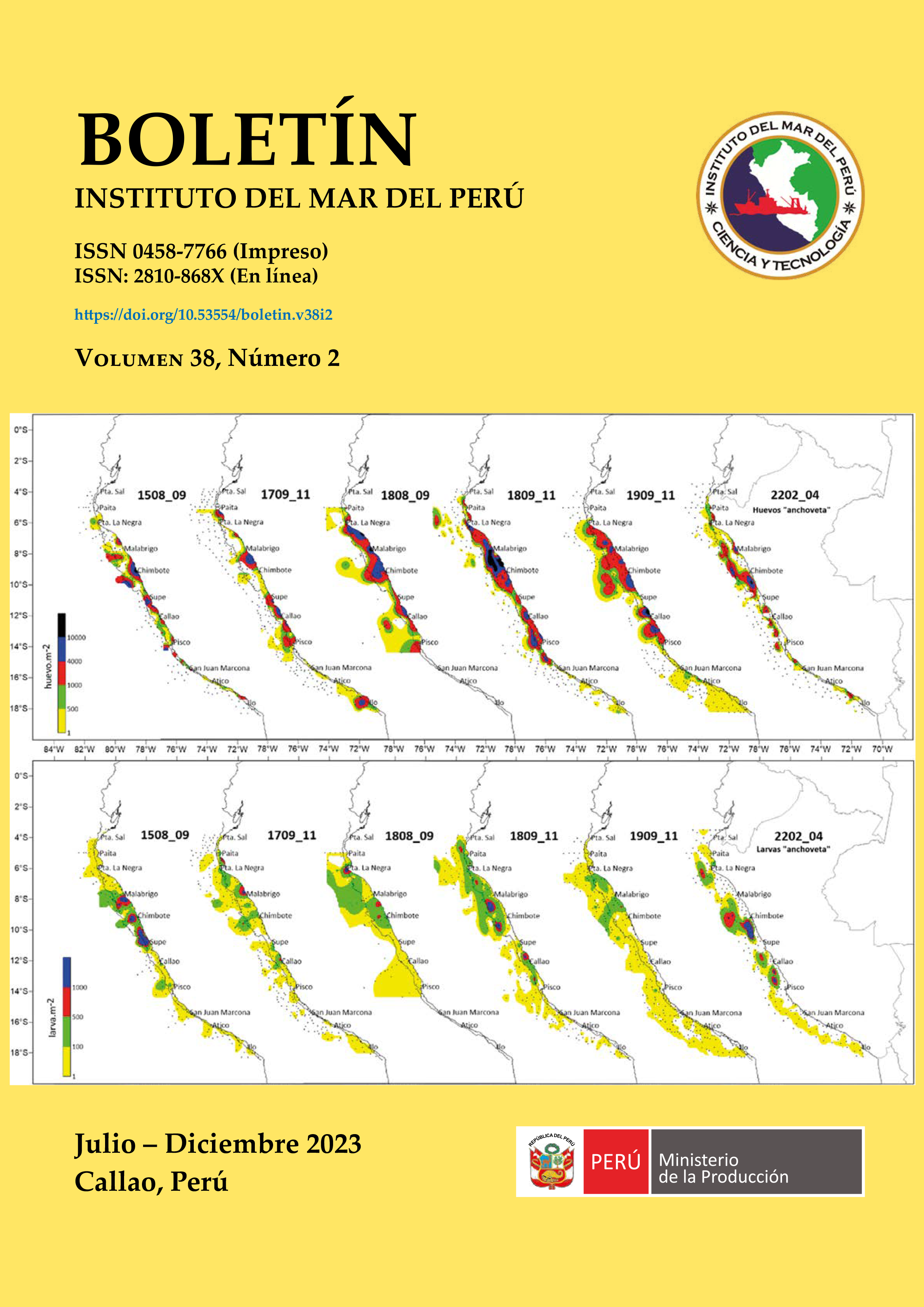Zooplankton biovolumes, distribution and abundance of ichthyoplankton, euphausiids, and cephalopod paralarvae (summer 2020)
DOI:
https://doi.org/10.53554/boletin.v38i2.392Keywords:
Biovolumes, Ichthyoplankton, Euphausiids, Paralarvae, Engraulis ringensAbstract
In the summer of 2020, zooplankton biovolumes ranged from 0.005 to 3.118 mL.m-3, with a median of 0.468 mL.m-3. The highest values were observed in the oceanic zone off the north-central coast of Peru, stretching from Punta Sal to Salaverry. Among the ichthyoplankton, the dominant families were Phosichthyidae (60.9 %), Myctophidae (56.2 %), and Engraulidae (43.8 %). Especially, Vinciguerria lucetia eggs (53.8 %) and larvae (52.3 %) were the most frequently observed. Engraulis ringens eggs were the most abundant, reaching densities of up to 44,802 eggs.m-2. These concentrations were primarily found in the coastal regions off Punta La Negra, Malabrigo, and north of Huacho. However, the larvae were less densely populated within the continental shelf, spanning from Punta La Negra to Chimbote. Among euphausiids, adult Euphausia eximia (23.3 %) and E. mucronata (22.5 %) were prevalent, alongside juveniles of Stylocheiron affine (18.6 %). The most abundant euphausiids were adult and juvenile E. lamelligera, with population densities of 7,929 and 8,829 ind.m-2, respectively. Cephalopod paralarvae, Argonauta spp. (810 ind.m-2) and Abraliopsis sp. (186 ind.m-2) were the most frequent and abundant species, respectively.
Downloads
Alternative Metrics
Metrics
References
Ayón, P. & Correa, J. (2012). Ictioplancton y volúmenes de zooplancton frente a la costa peruana, verano 2005. (BIC Olaya - BIC SNP-2: 0502-04). Inf Inst Mar Perú, 39(3-4), 233-238. https://hdl.handle.net/20.500.12958/2228
Ayón, P. & Correa, J. (2013). Variabilidad espacial y temporal de larvas de jurel Trachurus murphyi en el Perú entre 1966-2010. En: Csirke J., R. GuevaraCarrasco & M. Espino (Eds.). Ecología, pesquería y conservación del jurel (Trachurus murphyi) en el Perú. Rev. peru. biol., número especial 20(1), 083- 086.
Ayón, P., Criales-Hernandez, M. I., Schwamborn, R. & Hirche, H.-J. (2008). Zooplankton research off Peru: A review. Progress in Oceanography, 79(2), 238-255. https://doi.org/10.1016/j.pocean.2008.10.020
Boden, B. P., Johnson, M. W. & Brinton, E. (1955). The Euphausiacea (Crustacea) of the north Pacific. Bulletin of the Scripps Institution of Oceanography of the University of California, La Jolla. 6(8): 282 - 394. https://escholarship.org/uc/item/62h3k734
Brinton, E. (1962). The distribution of Pacific Euphausiids. Bulletin of the Scripps Institution of Oceanography of the University of California. 8(2):51-270. https://escholarship.org/uc/item/6db5n157
Correa, J. & Nakazaki, C. (2019). Volúmenes de zooplancton, distribución y abundancia de ictioplancton, eufáusidos y paralarvas, verano 2018. Bol Inst Mar Perú, 34(2), 456-472. https://hdl.handle.net/20.500.12958/3393
Einarsson, H. & Rojas de Mendiola, B. (1963). Descripción de huevos y larvas de anchoveta (Engraulis ringens J.). Bol. Ins. Recurs. Mar., Callao, I(1),1-23. https://hdl.handle.net/20.500.12958/64
Imarpe (Instituto del Mar del Perú). (2004). Anuario científico tecnológico IMARPE 2004. Vol. 4. Callao-Perú. https://hdl.handle.net/20.500.12958/1202
Imarpe (Instituto del mar del Perú). (2020). Situación del stock norte-centro de la anchoveta peruana (Engraulis ringens) al mes de mayo de 2020 y perspectivas de explotación para la primera temporada de pesca del año. https://cdn.www.gob.pe/uploads/document/file/1212747/Informe-correspondiente-Oficio-330-2020-IMARPE-PE20200807-1746888-1x1fi44.pdf?v=1596760261
Kramer, D., Kalin, M. J., Stevens, E. G., Thrailkill, J. R. & Zweifel, J. R. (1972). Collecting and processing data on fish eggs and larvae in the California Current Region. NOAA Technical Report NMFS, Circ-370. U. S. Department of Commerce. NOAA. National Marine Fisheries Service: 38 pp. https://spo.nmfs.noaa.gov/sites/default/files/legacy-pdfs/CIRC370.pdf
Moser, H. (1996). The early stages of fishes in the California Current Region. California Cooperative Ocean Fisheries Investigations, 73(3), Atlas Nro. 33, 1505.
Nakazaki, C. & Ayón, P. (2012). Volúmenes de zooplancton y distribución del ictioplancton en el litoral peruano durante verano 2006. Inf Inst Mar Perú, 39(3-4), 267-274. https://hdl.handle.net/20500.12958/2232
Nakazaki, C. (2012). El zooplancton entre Tumbes e Ilo, verano 2004. Inf Inst Mar Perú, 39(3-4), 218-226. https://hdl.handle.net/20.500.12958/2226
Orosco, X. (2016). Variabilidad espacio-temporal de paralarvas de cefalópodos en el mar peruano entre los años 2013 y 2014 [Tesis de pregrado]. Universidad Ricardo Palma.
Santander, H. & Sandoval De Castillo, O. (1973). Estudio sobre la primera etapa de vida de la anchoveta. Inf Inst Mar Perú, 4, 1-30. https://hdl.handle.net/20.500.12958/269
Sweeney, M. J., Roper, C. F. E., Clyde F. E., Mangold, K. M., Clarke, M. R. & Boletzky, S. V. (Eds.). (1992). Larval and juvenile cephalopods: a manual for their identification. Smithson. Contributions to Zoology, 513, 282. https://doi.org/10.5479/si.00810282.513
Van Guelpen, L., Markle, D. F. & Duggan, D. J. (1982). An evaluation of accuracy, precision and speed of several zooplankton-subsampling techniques. Journal du Conseil International pour L’exploration de la Mer, 40, 226-236. https://doi.org/10.1093/icesjms/40.3.226
Downloads
Published
How to Cite
Issue
Section
License
Copyright (c) 2023 Boletin Instituto del Mar del Perú

This work is licensed under a Creative Commons Attribution 4.0 International License.










